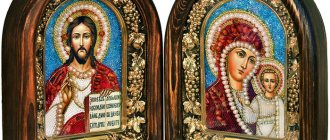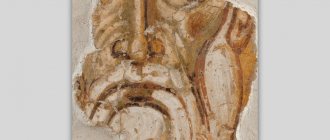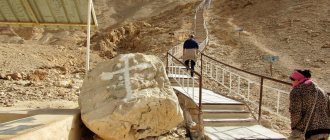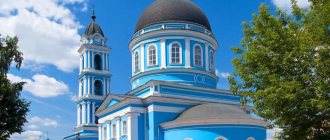Inscriptions on icons – conventional designations and abbreviations adopted in Russian Orthodox iconography.
The inscriptions can be made both in Church Slavonic and in Greek. In icon inscriptions, contracture (Latin contractura - tightening) is widely used - an abbreviated spelling of a word using an initial and final letter. A superscript abbreviation sign is placed above the contractures - titlo (҃)
An abbreviated inscription of the name Jesus Christ, composed of two pairs of letters under the titles:
. The baptismal halo (the so-called cruciform prostration), reminiscent of the Savior’s death on the cross, the redemptive action of which embraces the whole world - “cruciformly, as if by the cross you wished to save the world.” Number 4 is an image of spatial completeness. The four “ends” that make up the cross at the intersection connect the four cardinal directions.
The letters of the Greek word are written on the three visible sides of the halo cross
, which means Jehovah. The technique appears around the 11th century. This inscription emphasizes the Divinity of Jesus Christ, according to the revelation to the former Moses from the bush: “I am who I am” (Ex. 3:14).
In the Russian icon painting tradition, the Greek letter
(omega) is often replaced by the letter (from).
On Greek and Bulgarian icons the letter
(omicron) is located on the left, (omega) is at the top, (nu) is on the right, and the inscription is read in a circle from left to right.
On Russian icons, another letter order is more common: on the left
(about) or (from), above (he), on the right (our). The inscription is read line by line, starting at the top and then from left to right in the second line.
It is worth noting that the biblical explanation of letters in Rus' was not the only one. From Old Believer literature, a different interpretation is known, perhaps somewhat naive, but not violating the dogmatic provisions of the Church. In accordance with it, three letters express, firstly, the trinity of God; secondly, the Deity of Jesus Christ:
(from) - “there are also father marks.” (he) - “oum” (mind), (our) - “incomprehensible”; and, thirdly, the incarnation of the Son of God and His suffering: (from) - “came from heaven”, (he) - “they did not know Me”, (our) - “crucified on the cross.”
As follows from these interpretations, the order of reading letters in Rus' was also not uniform and could change, completely breaking with the Greek tradition and replacing the word “existent” with the abbreviation
.
God[ | ]
- Θεος
- God (Greek) - Bg
- God - Where
is the Lord
Jesus Christ[ | ]
- IC XC, ΙΣ ΧΣ
- abbreviated spelling of the Greek name. Ιησους Χριστος[3] - IIS XC
is an abbreviated spelling of the name of Jesus Christ. Distributed after the church schism of the 17th century. as a response to the traditional Russian spelling of the name “Isus” with one “i”, supported by the Old Believers, one of whose arguments was the inscription “IC XC” on ancient icons[3]. - IСЪ ХСЪ
- Isus
- ΙΧΘΥΣ
- literally “fish”, Greek acronym for Greek. Ιησους Χριστος Θεου Υιος, Σωτηρ - Jesus Christ the Son of God, the Savior [3] (see ichthys). - ο ων
(Greek) - an abbreviated spelling of the name of God “I am”, “I am who is” - “I am who is” (Exodus 3:14). The inscription of the name of the Holy Trinity on the cross-shaped halo on the icons of Jesus Christ [3]. - King of Glory
- King of Glory
WHAT WERE THE ORTHODOX EPITAPHS FROM THE BIBLE
An epitaph is a short, succinct and meaningful appeal of the deceased to the living, if he managed to leave one. If this does not happen, an inscription is made on behalf of the relatives. This may be an appeal to Christ in the hope of resurrection. Quotes from the Gospel, Bible, Holy Scripture.
What was written on tombstones in the 15th – 19th centuries
In the Middle Ages, when everyone was a believer, the following sayings were carved on graves:
- I look forward with all Christians to the joyful resurrection from the dead;
- (Name) died (date) in the true faith, his dear wife (Name) was united with him in death (date), as she was with him during life. They rest here in hope of eternal life.
- (Name) and his beloved wife (Name) passed away on (Dates), saddening their devoted children. His father's name died after him. (This means that the spouses did not have an heir and continue the family line, but only daughters).
- I want my Savior to live, and then to awaken me from the depths of the earth to bliss...
- Suffering in life and suffering in the grave, I am yours, Christ - awaken me to eternal life...
Unfortunately, now such thoughtful epitaphs can no longer be found on graves. There is no unshakable faith in Christ and in the resurrection to eternal life...
Crucifixion of Christ[ | ]
- I.N.
Ts.I. - an abbreviated inscription on the images of the “Crucifixions”, a sign of the words written in three languages (Hebrew, Greek and Latin) by Pontius Pilate on a tablet nailed above the head of the Savior: “Jesus of Nazareth, King of the Jews” (see INRI)[3] - ML RB
- abbreviation for “the place of the frontal paradise was”, or “the place of the forehead was crucified” inscription when depicting the Crucifixion[3] - ΤΚΠΓ (Greek) - short for Τουτο (or Τουτο) Κρανιον Παραδεισος Γεγονε - analogue of the Russian inscription MLRB [3]
- GG
- Mount Golgotha, the inscription at the foot of the Cross when depicting the Crucifixion[3]. - GA
- Adam's head (symbol), inscription on the skull depicted at the foot of the Crucifixion[3] - K
- copy - one of the instruments of passion, depicted at the Crucifixion (see Spear of Destiny) [3] - T
is short for “cane” - one of the instruments of the passions, depicted at the Crucifixion[3] - CT is an abbreviation for “spear” and “cane”, the signature of the instruments of the passions in images of the Crucifixion[3].
Saints[ | ]
- ΑΓΙΟΣ, αγιος, AGIOS
- Greek. saint. Often the word “hagios”, as bearing a sacred meaning, was shortened, often to a hieroglyphic sign with a title. As the initial text of the unceasing angelic doxology in the name of the Holy Trinity, the threefold repetition of the word “agios” can be found in images of angels[4] - ΑΓΙΑ, αγια, AGIA
- Greek. saint[4]. - HOLY, STY, STN, STI, ST, SV
- holy - FACK
- holy - OKA, OAK
- righteous (Greek) - PRO
is a prophet - APL
- apostle - STL
- saint - MCH, MCHNK
- martyr - PR
- Reverend
Notes[ | ]
- Inscriptions on icons. ABC of Christianity (undefined)
(inaccessible link). Access date: July 24, 2013. Archived November 7, 2013. - Illustrated Dictionary of Icon Painting // K
- ↑ 12345678910111213
Foreign words, abbreviations and abbreviations. Illustrated Dictionary of Icon Painting - ↑ 12
Illustrated Dictionary of Icon Painting // A
Font in Russian icons
Russian pre-Mongol icons were signed with a charter - a symmetrical, static, solemn letter. Later, semi-usta began to be used - a letter with a large number of asymmetrical elements. Inscriptions of prayer images and stamps, small icons of the Holidays often begin to be signed differently: large images - in solemn script, and stamps - in semi-character, reminiscent of book texts. By the middle of the 16th century. the script begins to change, become more complex, and it is often less readable. The letters are lengthened, and many of the round elements of the letters are built on the basis of vertical straight lines. The stamps begin to be signed in a cursory semi-character, almost in cursive. In the 17th century The readability of the font is often further deteriorated: the letters are often significantly elongated, and the inscription on the icon is a lot of vertical lines with various connections. Letters became more complex in other ways. In the middle of the 17th century. In connection with the verification of icon painting in relation to the Greek tradition, borrowings of new Greek fonts appear on Russian icons. In the XVIII-XIX centuries. the font on traditional icons does not change significantly.
| Novgorod. XII century | Glorification of the Cross. Reverse of the icon “Savior Not Made by Hands”. |
| Novgorod. XIV century | Apostle Peter |
| Tver. XV century | The Holy Trinity |
| Moscow. XV-XVI centuries | Dionysius. Metropolitan Peter with his life. |
| Vologda. XVI century | Praise to the Virgin Mary |
| Moscow. XVII century | Mary Magdalene and Evdokia |
| Palekh. XVIII century | Nativity |
| Mstera. XIX century | Paisius the Great |
Quoted from:
ed. T. V. Moiseeva. History of Iconography. Origins. Traditions. Modernity. M., “ART-BMB”, 2002.-290 p. ISBN 5-901721-12-8, p. 40
We bring to your attention the largest catalog of Orthodox sites:
Literature[ | ]
- Filatov V.V.
Brief illustrated icon dictionary: Book. for students. - M. - Education, 1996. - 224 p. - Galchenko M. G.
Inscriptions on Old Russian icons of the 12th-15th centuries: paleographic and graphic-orthographic analysis. - M.: Nauka, 1997. - 172 p. - Sablina N.P.
Words under titles: Dictionary. Inscriptions on the Cross of the Lord and holy icons. - St. Petersburg. : Izhitsa, 2001. - 44 p. - Galchenko M. G.
Book culture: book writing. Inscriptions on icons of ancient Rus'. Selected works. - St. Petersburg. : Aletheia; St. Petersburg, 2001. - 490 p. - Inscriptions on icons // Moiseeva T. V.
History of Icon Painting. Origins. Traditions. Modernity. - M., "ART-BMB", 2002. - 290 p. ISBN 5-901721-12-8 - Filatov V.V., Kamchatnova Yu.B.
Names and inscriptions on icon images: a reference book for icon painters. - Moscow: Orthodox pedagogy, printed. 2004. - 349 p. — 1000 copies. — ISBN 5-98571-013-0
Icon of the Mother of God “The Sign”
Novgorod Icon of the Mother of God “The Sign”. XII century Saint Sophia Cathedral. Velikiy Novgorod
The oldest image of the Mother of God “The Sign” in Rus' is the Novgorod icon, painted in the second quarter - mid-12th century. But the name “Sign” begins to be associated with it, oddly enough, only at the end of the 15th century, especially clearly from the 16th century, and is finally consolidated in the 17th century. They began to celebrate the feast of the icon on November 27, apparently, even before the miracle it showed to the Novgorodians, which happened on February 25, 1169 (1170). The First Chronicle of Novgorod reports that the Novgorodians defeated the Suzdalians “by the power of the cross and the Holy Mother of God” [1], that is, no name has yet been associated with the icon. The chronicler simply calls the icon “the Holy Mother of God,” without a specific epithet. The word “sign” was then usually used in the same meaning as in V.I. Dahl: “A sign is a sign, a sign, a sign; brand, tamga, seal; natural phenomenon or miracle for sign, proof; a foreshadowing of something”[2].
The etymology of the word “sign” is directly related to the verb “to know.” Indo-European ĝen – “to know” is identical to ĝen – “to give birth, to be born” and comes from this latter[3]. It is the concepts “to be born” and “to know” that make up the meaning of the word “sign”.
Let us consider the symbolic and theological meanings of the iconography of the image. At the same time, let’s not forget about the conventions of the language of the icon and the difference between the image and the depicted. I.K. Yazykova writes: “At the moment of contemplating the icon, the Holy of Holies, the inner Mary, is revealed to the one praying, in whose bosom the God-man is conceived by the Holy Spirit”[4]. Let's emphasize this “as if.” With this caveat, one of the meanings of the circle in which Emmanuel is depicted should be understood and perceived as a symbol
revelations.
But still, revelation
is a Divine sign.
And although the most secret things are revealed to us, nevertheless this is only the first stage of the icon’s conversation with us, when a sign is a “foreshadowing of something.” At the second stage, the Mother of God, knowing
the Savior even before Christmas, while still in the womb,
gives birth
- in the icon, as if eternally sending - the Infant of God into the world for the salvation of the human race.
Icon of the Mother of God “The Sign”. Con. XVI century Collection of P.D. Corina
The hands of the Mother of God are raised to the sky, they are open to meet the One who is above the entire universe, and at the same time they bless those praying. This is a very ancient prayer gesture: according to Tertullian, the hands of Christians of his time were raised and spread out, “imitating the passion of the Lord”[5]. The raised hands of the Mother of God in prayer also mean intercession for people before God. The inscription on one of the Byzantine seals of the early 13th century reads: “Ostretching out Your hands and offering Your intercession to the entire universe, give me Your protection, O Most Pure One, for what I must do.”[6] Moses also prayed with his hands raised to heaven during the battle between the Israelites and the Amalekites: “And when Moses lifted up his hands, Israel prevailed, and when he lowered his hands, Amalek prevailed; but Moses' hands grew heavy, and then they took a stone and put it under him, and he sat on it, and Aaron and Hur supported his hands, one on one side, and the other on the other side. And his hands were raised until the sun went down” (Ex. 17: 11–12). Here the significance of the entire psychophysical side of prayer is clearly confirmed: it is not enough to pronounce words in the heart; the posture of the person praying and his gestures play an important role. Let us also pay attention to the theme of light and grace that accompanies this gesture. The name “Aaron” is translated as “mountain of light”, “Or” - “light”. And the hands of Moses himself were “raised until the sun went down,” that is, the hands, supported by “lights,” stretched out to the Light and received the grace of God. In the same way, during the liturgy, the priest stretches out his hands in front of the throne, exclaiming: “Woe is our hearts.” Therefore, we can talk about the canonicity of this gesture, which has been used in the liturgy since ancient times, about the unique connection through this gesture of the Old and New Testaments.
Our Lady of the Great Panagia. OK. 1224 Tretyakov Gallery
The same thing is inherent in the iconography of the Mother of God image “The Sign”.
And here we see the fulfillment of the Old Testament in the New. The Infant of God is figuratively symbolic, but from eternity he is born
into the world for its salvation.
That is why He is often placed in a mandorla, through the circles of which Divine energies seem to emanate into the world (again, the theme of light and grace, reflected even in the color of Emmanuel’s clothes). The mandorla in this case acts as a sign
of movement - the movement of the Baby and light.
And when, during the siege of Novgorod, an arrow from the Suzdalians hit the icon and the icon turned away from the attackers, the Suzdalians thereby lost light and grace, and the Novgorodians, on the contrary, received this grace for decisive action and victory over the enemy. Let us remember that the Greek ενέργεια is translated as active force, and a sign, according to V.I. Dahl, there is a sign. But in Greek a sign - σημειον - is a miraculous sign, not an ordinary one. In the Novgorod Festive Menaion (c. second quarter of the 14th century), this word in relation to the miraculous icon is used precisely in the meaning of “omen”, “miracle”. Another purpose of the mandorla in this case is to emphasize the Christocentrism of the icon: both with concentric circles around the Infant God - “Light has come into the world” (John 3: 19)[7], and with its high hierarchical status in the system of iconographic symbols. The hands of the Infant God stretched out from the medallion in the Great Panagia
(from the Greek Παναγία - All-Holy) indicate the penetration of eternity into time[8], and therefore the abolition of time, which is characteristic of the Orthodox worldview[9].
So, the first meaning of the “Sign” icon is revelation. At the same time, there is another meaning hidden in it: Christians, for their part, will recognize
The birth and coming into the world of the Savior,
we know
Him and testify of Him as
recognized
. That is, birth (γέννησις), in fact, occurs in the name of creation (γένεσις), in order to return creation to the Divine plan: so that man becomes a created god by grace. In other words, without division and confusion, the dual unity of “God and me” arises - the unity that S.L. wrote about in his time. Franc. Let us recall that the word “Divinity” in theology indicates a property, a nature, and the word “God” indicates a Person. As a super-temporal or timeless act, the words of the prophet Isaiah are fulfilled: “Behold, a virgin will conceive and give birth to a Son, and they will call His name Emmanuel, which means: God is with us” (Is. 7: 14; Matt. 1: 23). In the 15th century, this text of Isaiah is shown not only on the icons of the prophetic order of the iconostasis, as in the Assumption Cathedral of the Kirillo-Belozersky Monastery[10], but also serves as the basis for free literary adaptations, in which the word “sign” is used in relation to prophecy[11] .
The religious experience of prayerful communication with an icon allows you to discover a new state in yourself, filled with Divine energies. The Greek term ένθεος[12] - lit., is suitable for its designation. "filled with divinity." This state is indicated by the words of Christ: “The kingdom of God is within you” (Luke 17:21). We are clothed with Christ, and Christ abides in us. In this case, on a personal level, a real relationship is established between the Prototype and a person through the icon, and on a public level, the icon becomes a national shrine. Thus, the image of the Mother of God “The Sign” became the sacred guardian of Veliky Novgorod. This icon was also considered in Byzantium and Rus' to be the patroness of the Church, which explains the frequent use of its iconography on the seals of monasteries, dioceses and metropolises[13], in lunettes above the entrance to the temple[14], in apse conchs[15]. There are grounds for establishing a connection between the image of the Mother of God “The Sign” and the icon of the Annunciation. If in the bosom of Mary “the God-man is conceived by the Holy Spirit,” as I.K. theologically correctly noted. Yazykov, then this is the beginning of the fulfillment of the prophecy about Emmanuel: the good news has entered the stage of its implementation. Therefore E.S. Smirnova is absolutely right in considering the images on the reverse side of the icon to be images of Joachim and Anna, and not of the Apostle Peter and the martyr Natalia, as V.N. believed. Lazarev with followers. The theme of the Incarnation is central to the “Sign” icon (therefore, this iconography is canonical for the center of the prophetic order of the iconostasis). Both sides of the famous Novgorod image, with increasing content, testify precisely to the Incarnation. Otherwise, the theological connection between the obverse and reverse of this icon is lost, which comes into conflict with the practice of church life. A similar connection was present in the vast majority of external Orthodox images.
Oranta. Fragment of the vault painting. Second half of the 3rd century. Catacombs of Callistus. Rome
A special rite in honor of the Mother of God, called the “Rite of Raising the Panagia,” is directly associated with the “Sign” icon.
But we know that Panagia is also called an encolpion - a small image of the Mother of God, worn by the bishop on his chest over his vestments, and a prosphora, from which a particle was removed during the liturgy in memory of the Most Pure One. During the meal, the prosphora was always placed on a special dish - panagiar - with the image of Our Lady of the Sign, often surrounded by prophets. On the Byzantine panagiars of the 12th–13th centuries you can see the inscription: “Christ is Bread. The Virgin gives body to God the Word.” The inscription was applied not only for decoration; its meaning was to mysteriously unite the rite of Panagia
and the meaning of the holy bread - the body of Christ, which He received from His Mother.
Thus, the rite of Panagia
returns us to the theme of the Incarnation.
The genealogy of the iconography of the “Sign” goes back to the image of Oranta, which in Rus' was also called the “Unbreakable Wall” because “it was considered the intercessor of “all cities, suburbs and villages” in the fight against eternal enemies - the steppe nomads”[16]. Is it correct to believe that Oranta was depicted as an intercessor, starting with the paintings of the catacombs? In them you can see many images similar in iconography: this is how, for example, the souls of the dead were originally depicted, who prayed for Christians who were still living.
Ampoule of Monza. VI–VII centuries Byzantium, Palestine
Oranta was and is a symbol of the Heavenly Church. She became such fully and consciously from the moment she was identified with the personality of the Mother of God. Already in the catacombs, “under the image of a praying wife, ancient Christians sometimes used to depict none other than the Blessed Virgin Mary,”[17] accompanying the frescoes with the inscriptions “Maria” and “Mara.” However, “in these orants we do not have a portrait, individual type of the Mother of God, but a conventional image of Her, accepted for every sedate Christian woman”[18]. However, in the “Ascension” stamp of the Monza ampoule (the iconography of the stamps dates back to the 4th–6th centuries), we see Oranta, undoubtedly, in the person of the Mother of God, we see Her as the personification of the Apostolic Church.
Since the 9th century, the Most Pure One began to be painted in the apse conch. As noted by I.K. Yazykov, since then “the theme of intercession takes on a broader aspect: the prayer of the Mother of God links together the Kingdom of Heaven, represented in the upper part of the temple, with the “downstream world” - under Her feet. Our Lady of Oranta, as it were, opens up to meet Christ, Who descends through Her to earth, incarnates in human form and sanctifies human flesh with His Divine presence, turning it into a temple - hence Our Lady of Oranta is interpreted as the personification of the Christian temple, as well as the entire New Testament Church.”[19] .
Image of the Mother of God "Oranta". Fresco. Serbia. XIV century
In the 14th century, Serbian isographers painted a fresco similar to the Novgorod icon “The Sign”, where the Mother of God, depicted full-length, is dressed not in the usual tunic, but in a chiton with claves. Similar examples can be seen on some of Oranta's frescoes in the catacombs. The Mother of God in this case was understood as the Church itself and as a messenger. If earlier the intercession of the Most Pure One implied a movement from the earthly to the heavenly, here it is understood as apostolic and directed from the heavenly to the earthly.
Protographs of the image of the Mother of God “The Sign” have also been known since the 4th century (the catacombs of St. Agnes in Rome) and, judging by the absence of a halo on the Infant of God, they were created before the First Ecumenical Council, that is, before 325. And in the 5th–6th centuries they were already written on icons and in the wall paintings of churches, minted on coins, and reproduced on the seals of the Byzantine emperors, which indicates their Constantinople origin. This iconography became especially widespread from the 11th to 12th centuries and became popular throughout the Orthodox ecumene. However, many art historians consider the time of appearance of this version to be only the middle of the 11th century, citing surviving images of coins (nomisma of Empresses Zoe and Theodora, 1042) and sphragistics (seals of Empress Eudokia Macremvolitissa, wife of Constantine X in 1059–1067. and Roman IV in 1068–1071). Apparently, the confusion here occurs due to an unclear classification of the names of iconographic types, since the tradition of fixing stable names for one or another type of Mother of God icons developed only at the time of the decline of the Byzantine Empire, and possibly later - already in post-Byzantine times.
According to I.K. Linguistically, the iconography of Oranta is an abbreviated and truncated version of the image of the Mother of God “The Sign”. Such an opinion cannot but cause objections. Since Oranta’s version is older than the “Sign”, the first cannot be a “shortened version” of the second: you can only truncate what already exists. Here we are not dealing with a reduction in the iconography of the image, but with its construction. Therefore, the “Sign” scheme is more complex than the Oranta scheme, not only externally, but also internally. “This is the most theologically rich iconographic type,” I.K. herself is convinced. Yazykova[20].
Icon of the Mother of God "Blachernitissa". Ser. XIII century Monastery of St. Catherine. Sinai
We have already ascertained from the example of Cypriot frescoes[21] the undoubted connection between the images of the image of the “Sign” and the image of the Mother of God Blachernitissa[22], which only confirms the understanding of the word “sign” as a miracle, because the events of 910 that took place in the Blachernae Church[23] , have been celebrated by the Russian Orthodox Church for more than eight hundred years as the Feast of the Intercession of the Mother of God. Apparently, it is natural that the icon is called “The Sign” only in Rus' and nowhere else. In other countries it is known under other names, mainly taken from akathists.
In the art of the Byzantine circle, several terms were used for this iconography, which are often used by art historians: “Platitera” (from “Πλαντυτέρα τόν ουρανόν” - “Broadening the heavens”, from the liturgy of Basil the Great), “Episkepsis” (“Επίσκεψις” – “Patroness , Intercessor”), “Megali Panagia” (“Μεγάλη Παναγία” – “Great All-Holy One”)”[24]. Let’s add here “Pantonassa” (“παντο” - “all” + “νάσσα” from “ναίω” - “to live, inhabit; be; inhabit”).
Icon of the Mother of God "Platitera". XV century Greece
It should be noted that there is a certain iconographic connection between the image of the Mother of God “The Sign” and the icon of
the Mother of God Nikopeia
(Victorious)[25]. During the restoration of the Blachernae Temple (1030–1031) during the reign of Emperor Romanus III Argir, builders discovered an icon walled up in the wall, which was hidden from the iconoclasts, most likely in the 8th century under Emperor Constantine Copronymus. The found image was described by a witness of the events, John Skylitzes. Its text has long been understood as a description of a translation identical to that of the Novgorod icon “The Sign,” but modern researchers have made a more accurate translation, from which it follows that the Mother of God holds a mandorla with the Infant God in Her hands. This is how Nikopea, known since pre-iconoclastic times, was found. A similar Sinai icon from the 7th century has survived to this day. The role of this excerpt, according to Academician N.P. Kondakova and V.N. Lazarev, echoes the role that the Novgorod shrine – the icon of the Mother of God “The Sign” – is called upon to play.
Icon of the Mother of God "Pantonassa". XV–XVI centuries Greece
Let us note how accurately our ancestors gave the name to the image! The miracle is inextricably linked with this icon. Especially for Novgorodians. Miraculously, they received help from her during the siege of the city by the Suzdalians. In 1356, a fire that broke out in the church subsided after a prayer service in front of this icon. In 1611, the Swedes who tried to rob it were thrown out of the Znamensky Cathedral. Relatively recently, many of those present witnessed a celestial phenomenon: on August 15, 1991, during the transfer of the icon from the museum, where it had been kept for a long time, to the Novgorod diocese, a rainbow surrounded the golden dome of the St. Sophia Cathedral, and then began to rise and dissolved in the clear, without a single cloud, sky.
In conclusion, let us recall that the word “miracle” is formed from the verb “sense” - that is, “hear, feel.” God, taking into account human nature, turns to them with the help of signs to save His people. As long as we “feel” the all-presence of God and the universal protection of the Mother of God, we can hope for Her intercession and help in sorrows. And through Her image “The Sign” the luminous grace of God will continue to descend upon us.







